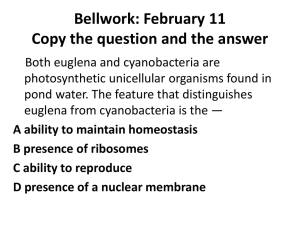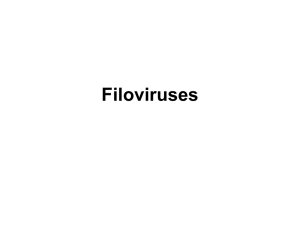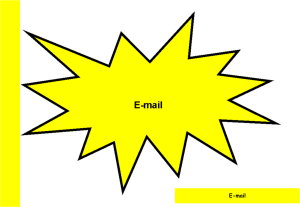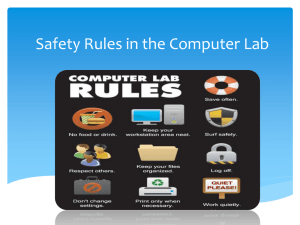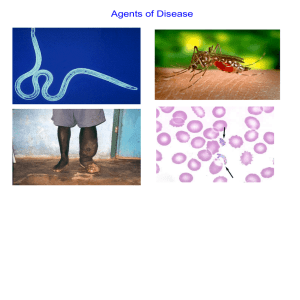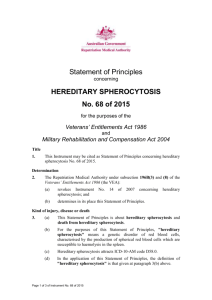Chapter 2
advertisement
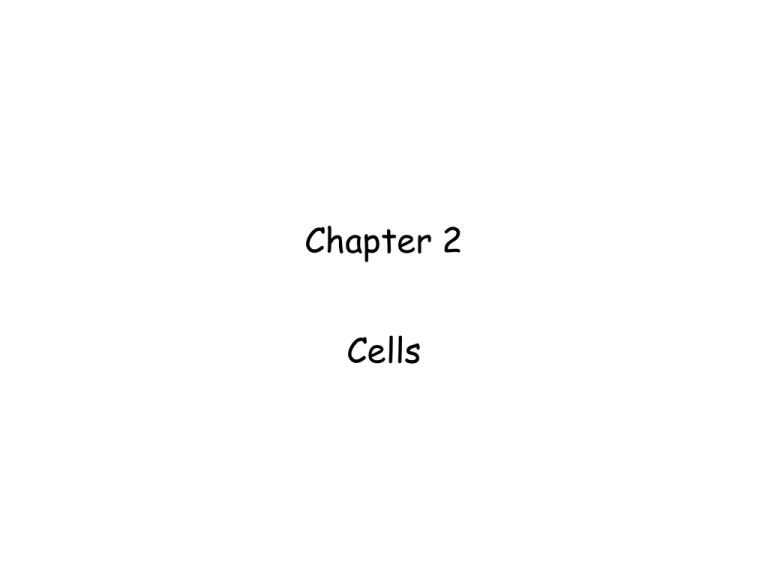
Chapter 2 Cells Section 1-Cell Structure • Common cell structures – outer covering-_________________ – internal gelatinlike cytoplasm – hereditary material • Comparing cells- Section 1-Cell Structure • Two cell types – Prokaryotic- __________membrane-bound internal structures – Eukaryotic-___________membrane-bound internal structures Section 1 Cell Organization • Composed of cellulose, a ___________ grows, changes shape, and protects the cells of plants, algae, fungi, and most bacteria. • Cell __________-protective layer around all cells. – allows food and oxygen into the cell and waste products out of the cell. Section 1 Cell Organization • _____________-gelatinlike substance inside the cell membrane. – ______________ scaffolding-like structure in cytoplasm which helps cell keep its shape. – Eukaryotic cells have ___________ which help with cell like processes. Section 1 Cell Organization • ________________ contains instructions for everything a cell does; includes DNA CODE Section 1 Cell Organization • Energy-processing organelles- help cells do their work – Green organelles in plant cells contain ____________ to make food. green pigment=chlorophyll – Organelles which release energy from food are called _______________. Section 1 Cell Organization • Manufacturing organelles – ______________ make proteins for cell activities. – Some ribosomes attach to the rough part of the endoplasmic reticulum. Section 1 Cell Organization • Transporting and storing organelles – ______________move substances out of a cell or to other parts of a cell. – ______________membrane-bound temporary storage space. Section 1 Cell Organization • Recycling organelles – _______________break down food molecules and cell waste. Section 1 Cell to Organism • Cells work together to keep an organism alive. – ________ group of similar cells working together on one job. lining inside mouth – Different types of tissues working together make up an _________. kidney – A group of organs working together on a particular function form a ___________. heart, blood, and vessels Section 2-Viewing Cells • Magnifying Cells – Early microscopes- lenses made images ________, but not always clear. Section 2 Viewing Cells • Modern microscopes- use lenses to bend light – A simple microscope has one lens while a compound microscope has multiple lenses. – A stereomicroscope, which has two eyepieces, creates a threedimensional image. – Powers of the eyepiece multiplied by objective lenses determine total magnification. Section 2 Viewing Cells • Electron microscopes- more powerful than other microscopes. – Use a _____________ in a vacuum to bend electronic beams. – Images must be photographed or produced electronically. Section 2 Viewing Cells • Development of the cell theory – The cell theory resulted from many scientists’ observations and conclusions. – The basic unit of organization is the cell. – All organisms are composed of one or more cells. – New cells come from old cells through cell division. Section 3-Viruses • ___________ - a nonliving strand of hereditary material surrounded by a protein coating. • Virus multiplication- viruses can make copies of themselves only inside a living ___________ cell. – Active viruses make the host cell create new viruses, which kills the host cell Section 3 Viruses • 5 steps of active virus multiplication – virus attaches to host cell – hereditary material enters host cell – hereditary material causes the cell to make viral hereditary material – new viruses form inside the host cell – viruses are released as the host cell bursts Section 3 Viruses – __________viruses hide in the host cell without destroying it. • virus hereditary material becomes part of the host cell hereditary material • latent viruses can become active and then destroy the host cells. Section 3 Viruses • Viruses effects on organisms – most viruses infect only specific kinds of cells – viruses are often carried to the host through the air – the virus and host cell must fit together exactly to begin a viral infection. – _____________attach to bacteria and inject their hereditary material. Section 3 Viruses • Fighting Viruses – __________- weakened virus particles which allow the host to fight some diseases Section 3 Viruses • Treating viral diseases – _______________ are not effective treatments for viral infections – Infected cells sometimes produce ____________, which are proteins that can protect non-infected cells. – Antiviral drugs often have adverse _____________, limiting their use. – Public health measure can _________ or slow disease spread. Section 3 Viruses • Research – ________________ uses viruses to replace defective cell hereditary material with normal cell hereditary material.


